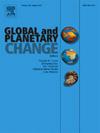Palaeoenvironmental evolution of the Northeastern Tibetan Plateau and its response to global temperature change during the Late Miocene: Geochemical and clay mineralogical evidence from the Jianzha Basin
IF 4
1区 地球科学
Q1 GEOGRAPHY, PHYSICAL
引用次数: 0
Abstract
Aeolian deposits on the northeastern Tibetan Plateau (NETP) are valuable archives of the interaction between plateau uplift and climate change. We used the clay mineral assemblages and geochemistry of aeolian red clay in the Jianzha Basin, on the NETP, to reconstruct its paleoenvironmental evolution during the Late Miocene. We compared these data with those for surrounding basins and with global temperature changes sheds light on the relationship between regional tectonic-climatic processes and global changes on the NETP. Geochemical proxies of provenance change (Th/Sc, Zr/Sc, Eu/Eu*, LaN/YbN, and Zr/Cr) indicate a significant tectonic uplift event at ∼8.5 Ma on the NETP. Chemical weathering proxies (Rb/Sr, Li/Sr, and Ba/Sr) of bulk samples may be affected by sedimentary sorting. Hence, we used clay mineral (It = illite, Ch = chlorite, I/S = illite/smectite mixed layers, and Kao = kaolinite) and their assemblages ([S + I/S + Kao]/(It + Ch), (S + I/S)/(It + Ch), and (S + I/S)/It) to show that the climate of the Jianzha Basin tended towards aridity before ∼8.5 Ma and after ∼7.2 Ma. Conversely, during ∼8.5–7.2 Ma, the relatively humid environment in the Jianzha Basin was affected by both tectonic uplift and the intensification of the East Asian summer monsoon precipitation. Our study suggests that global temperature change controlled the climate of the NETP during the Late Miocene, and regional tectonism reinforcing this effect as a secondary controlling factors.
求助全文
约1分钟内获得全文
求助全文
来源期刊

Global and Planetary Change
地学天文-地球科学综合
CiteScore
7.40
自引率
10.30%
发文量
226
审稿时长
63 days
期刊介绍:
The objective of the journal Global and Planetary Change is to provide a multi-disciplinary overview of the processes taking place in the Earth System and involved in planetary change over time. The journal focuses on records of the past and current state of the earth system, and future scenarios , and their link to global environmental change. Regional or process-oriented studies are welcome if they discuss global implications. Topics include, but are not limited to, changes in the dynamics and composition of the atmosphere, oceans and cryosphere, as well as climate change, sea level variation, observations/modelling of Earth processes from deep to (near-)surface and their coupling, global ecology, biogeography and the resilience/thresholds in ecosystems.
Key criteria for the consideration of manuscripts are (a) the relevance for the global scientific community and/or (b) the wider implications for global scale problems, preferably combined with (c) having a significance beyond a single discipline. A clear focus on key processes associated with planetary scale change is strongly encouraged.
Manuscripts can be submitted as either research contributions or as a review article. Every effort should be made towards the presentation of research outcomes in an understandable way for a broad readership.
 求助内容:
求助内容: 应助结果提醒方式:
应助结果提醒方式:


